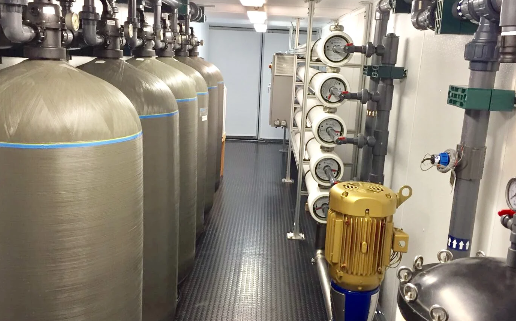Commercial Water Desalination: Addressing Global Water Scarcity
Water scarcity is a pressing issue affecting communities worldwide, driven by factors such as population growth, urbanization, and climate change. In regions where freshwater sources are limited, desalination has emerged as a viable solution to augment water supplies and meet growing demand. Commercial water desalination, in particular, plays a crucial role in providing safe and sustainable water resources for various industries and municipalities.
Understanding Water Desalination
Desalination is the process of removing salt and other impurities from seawater or brackish water to produce fresh, potable water suitable for human consumption, agriculture, and industrial use. There are several methods of desalination, including thermal distillation and membrane filtration, with reverse osmosis being the most commonly employed technique in commercial applications due to its efficiency and cost-effectiveness.
Reverse osmosis (RO) is a water purification process that relies on semi-permeable membranes to separate salts, minerals, and other contaminants from water. In a typical RO system, seawater is pressurized and forced through a series of membranes, allowing pure water molecules to pass through while blocking larger ions and particles. The resulting permeate, or freshwater, is collected and stored for distribution, while the concentrated brine is discharged or treated for disposal. Desalinated water undergoes rigorous treatment processes to remove salts, minerals, and contaminants, making it safe for human consumption.
Commercial water desalination plants are large-scale facilities designed to produce significant quantities of freshwater to meet the needs of industries, municipalities, and communities. These plants utilize advanced technology and engineering principles to desalinate seawater or brackish water efficiently and cost-effectively. Commercial desalination serves various purposes, including:
Municipal Water Supply
A dependable source of drinkable water for urban usage, desalination is especially useful in dry areas when freshwater sources are few or exhausted. Water that is both clean and safe to drink is readily available to people in metropolitan areas because to commercial desalination plants.
Water is essential for many industrial processes, including food production, electricity generation, and manufacturing. Businesses rely on commercial desalination to keep running efficiently and sustainably by supplying water of high quality for irrigation, cooling systems, and industrial activities.
Having access to clean water is absolutely crucial for humanitarian help and disaster relief during emergencies or natural disasters. Rapid deployment of commercial desalination facilities can alleviate the effects of water contamination and shortages by providing emergency water supply to impacted regions.
Desalination, which draws water from saltwater or brackish sources, creates a diverse and stable water supply that is not as affected by changes in precipitation or groundwater levels. Communities and enterprises benefit from increased water security and less reliance on limited freshwater resources.
Industrial expansion, seasonal changes, and population growth are just a few of the variables that might affect water consumption, but commercial desalination plants can be adjusted to match these needs. This adaptability guarantees that supply matches demand efficiently and permits adaptive water management measures.
While desalination does produce brine waste and necessitates energy inputs, newer technologies have made the process more effective and provided creative ways to dispose of brine and recover resources. The environmental impact of commercial desalination plants is reduced and sustainability is enhanced through the implementation of best practices in environmental management. Energy prices, infrastructure investment, plant capacity, and techniques for disposing of brine are some of the elements that impact the cost of desalination. Over time, expenses can be reduced by technological advancements and economies of scale.
Desalination is a very power- or heat-hungry process that needs a lot of energy to run. Integration of renewable energy sources and energy-efficient technology is necessary since desalination uses a lot of energy, which can lead to carbon emissions and other environmental impacts.
Because of its high salt content and its influence on marine ecosystems, the dumping of brine—a concentrated desalination byproduct—poses environmental concerns. To reduce their impact on the environment, commercial desalination plants should use brine management measures including dilution, dispersion, or resource recovery. Because of the changes in water chemistry and the increased salt concentrations, marine habitats can be affected by brine discharge into coastal waterways. Environmental monitoring and proper brine management are crucial for minimizing ecological effects.
Even while desalination has become more affordable, it is still more costly than more conventional water sources like surface water or groundwater. Some communities may not be able to afford or access commercial desalination projects due to the high operational and capital costs. Sustainable operation of desalination facilities is possible through careful planning, design, and management approaches that reduce energy consumption, maximize recovery of resources, and lessen environmental effects.
Desalination is poised to become more crucial in addressing water demands, especially in areas where there is a persistent lack of water and a growing population. Realizing desalination’s full potential in water management methods requires ongoing investment and innovation in the field.
Conclusion
An important part of solving the world’s water problem and giving businesses, cities, and towns long-term water solutions is commercial water desalination. Commercial desalination plants ensure a dependable water supply for varied applications by producing high-quality freshwater from seawater or brackish water using advanced technology and engineering knowledge. Desalination has many advantages, but there are also some drawbacks, such as issues with energy usage, brine disposal, and financial concerns. The commercial desalination sector can maintain its global water security and environmental sustainability contributions by inventing solutions to these problems and working together.



